

Agridisk
Egypt - Alexandria
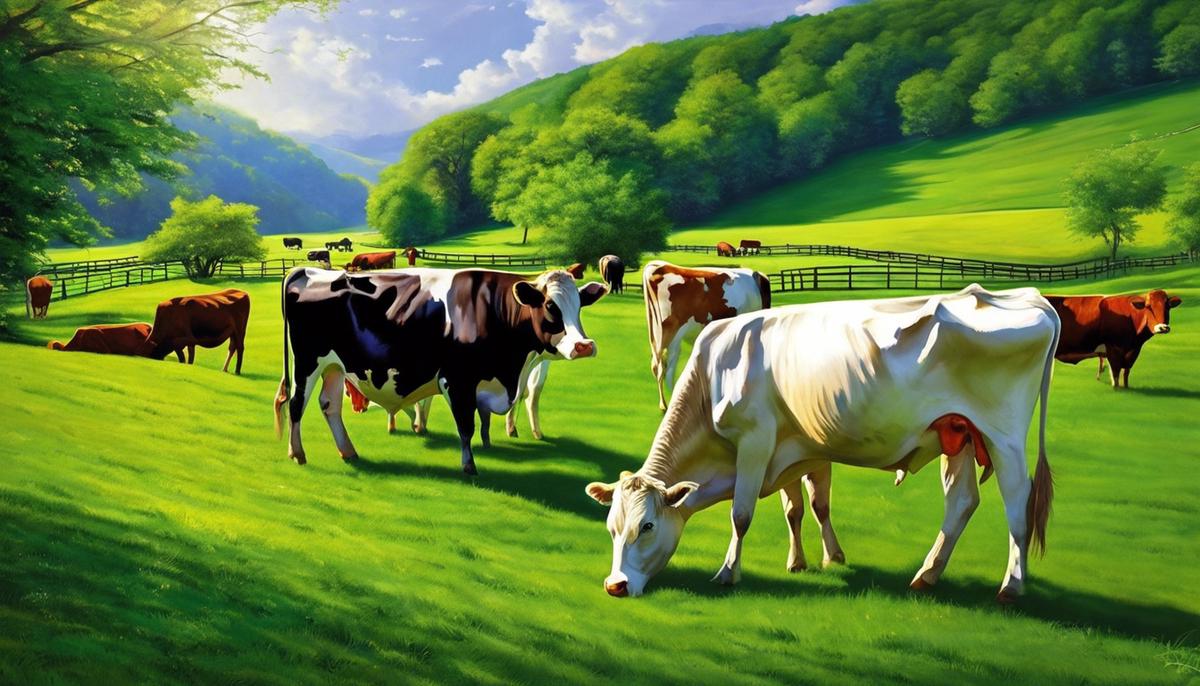
Dairy farming | How to start a Dairy farm business?
Description: In the tapestry of human civilization, the cultivation and development of dairy farming stand as a testament to humanity's innovative pursuit of sustenance. As old as the domestication of animals itself, dairy farming has a rich historical narrative that tells of humble beginnings, leveraging simple hand-milking techniques, and culminating in today's highly sophisticated, mechanized processes. Still, this dynamic industry grapples with diverse challenges that threaten its longevity, underscored by both natural and human-induced forces. However, vitality and resilience remain hallmarks of the dairy farming sector, invigorated by revolutionary technologies that promise to redefine its future. This discourse unravels these enthralling aspects of dairy farming, revealing their interplay in shaping the industry's present and future outlook. The pillar of civilization in agrarian societies, dairy farming, has long held a pivotal role in human life. From being a mere food source in the nomadic era to becoming an integrated component of the food industry, dairy farming has shaped significant aspects of human civilization. This piece endeavors to shed light on how, in its progress, dairy farming has laid the much-touted foundation for modern industry practices. Since the domestication of animals circa 8000 BC, the journey of dairy farming has been nothing short of extraordinary. It started with techniques like dairying and animal husbandry practiced by early humans, which consisted primarily of milking and caring for cattle. In reality, the antiquity of dairy farming, with its simple foundations, dictated a precedent for contemporary-day dairy operations. Illuminating this further, the early processes involved in dairy farming were constantly improved for efficiency and quantity, subsequently yielding better quality products. The mercantile revolution in the Middle Ages propelled widespread trade and distribution of dairy products, initiating a concerted focus on streamlining the production processes. Hence, the traditional methods of dairy farming translated into a mainstream business theme, setting a paradigm for other industries. The 19th Century marked a significant turning point for dairy farming with the onset of the Industrial Revolution. Innovation and discoveries in technology boosted productivity, confirming the economic importance of dairy farming. The advent of mechanical milking machines in the late 1800s revolutionized dairy farming practices, paving the way for mass production. These dramatic shifts captured the essence of modern industry, emphasizing efficiency, productivity, and technology as key operational tenets. Advancements didn't stop merely with mechanical inventions. The concept of scientific management found a home in dairy farming, epitomized through systematic breeding programs, herd management, and feed quality improvement. Dairy farms began to resemble factories, highlighting a shift towards industrial farming practices. These scientific approaches underline the modus operandi of many modern industries that stress innovation and process optimization. Further, the road to sustainability gave birth to brother principles like organic farming and veterinary medicine—an aspect that today’s industries heavily lean on for their CSR and sustainable practices. The journey from a survival tactic to an eco-conscious industry presents dairy farming as a model that demonstrates the potential of business evolution with time and necessity. Modern dairy farming's principles resonate deeply within the corners of the broader industry, reflecting its historical arc. As we delve deeper into the future, the cycles of revolution and innovation from the history of dairy farming continue to foster enhancements in modern industry practices. In summation, the history of dairy farming can be viewed as an enriching tapestry that unfurls an extraordinary narrative of human progress. It is a testament to man's relationship with nature, where the extraction of a simple resource pivots to become an industrial powerhouse, inspiring and informing the principles of modern industry. Building upon the rich history of dairy farming, modern practices have developed to maximize production efficiency and quality while leveraging a deep understanding of the biotechnological processes involved with milk production. The scientific principles underlying dairy production include biochemistry, genetics, and microbiology, each playing a central role in molding the current trajectory of the dairy industry. Biochemistry sets the fundamental technical groundwork for dairy production. Bovines, the main source of dairy products, possess a unique biological process for lactation. After parturition, hormonal signals (mainly oxytocin and prolactin) stimulate the mammary glands to produce milk. Comprising water, lactose, fats, proteins, and low levels of other nutrients, bovine milk is a complex, multi-component solution. The knowledge of the biochemistry of milk has facilitated the development of optimum feeding practices, ensuring healthier animals and better milk yields. Genetics and genomics have emerged as transformative elements in dairy production, taking advantage of comprehensive understanding of bovine genetics and advanced genotyping technologies. Selective breeding programs based on genetic markers have enabled the elevation of productivity and disease resistance. Cows with desirable traits like high milk yield, good fertility, and disease resistance are selectively bred, thus passing on these traits to subsequent generations. Microbiology is a third cornerstone in the scientific foundation of dairy farming. Beneficial bacteria play a crucial role in dairy production, especially in the creation of fermented dairy products like cheese, butter, and yogurt. For instance, the bacteria Lactococcus lactis and Lactobacillus are integral to the production of cheese, aiding in the fermentation process that forms curds. Understanding these microbial processes enables producers to take precise control over the final product's taste, texture, and shelf life. Additionally, knowledge of pathogenic microbiology aids in ensuring the safety of dairy products, with thorough pasteurization and quality control protocols aimed at eliminating harmful contaminants. Failure to mitigate pathogens, such as E.coli or Salmonella, can compromise the safety of consumers, underscoring the essential role microbiology plays in dairy production. The application of these scientific principles within the dairy industry has dramatically influenced how operations function today. From careful manipulation of feeding regimens based on biochemistry knowledge, implementing selective breeding programs grounded in genetics, to mastering fermentation processes contingent on microbiology -- the diary industry continually evolves, driven by scientific insight. Concurrent strides in technology have enabled swift application of this scientific knowledge, positioning dairy farming even more firmly in the realm of applied science. This synergy between science and technology guarantees that dairy farming will continue to innovate in response to evolving challenges and opportunities. It is this rich intersection of science, history, and technology that shapes the complexity and dynamism of the dairy industry, as we know it today. As dairy farming advances into the 21st century, the industry confronts an array of multidimensional hardships, all requiring innovative, practical solutions to ensure the prosperous continuation of this vital sector. Chief among these challenges is climate change, exerting significant pressures on dairy producers worldwide. Animal agriculture, including dairy farming, contributes an estimated 14.5% to global greenhouse gas emissions, a figure under constant scrutiny by environmentalists. Elevated global temperatures, unpredictable weather patterns, and increased frequency of extreme weather events adversely affect forage crop cultivation and water accessibility, jeopardizing animal health, milk production, and overall farm productivity. Strategies addressing this issue include increased precision feeding for improved digestion and methane reduction, genetic selection for climate-resilient animals, and farm-level adjustments such as improved water management and climate-smart infrastructure. Simultaneously, dairy farmers grapple with the economic volatility wrought by fluctuating milk prices. Market prices, impacted by numerous global and domestic factors, often do not meet production costs, placing farmers in precarious financial situations. Curative measures include diversification of dairy products, formation of cooperative societies that regulate milk prices in favor of producers, improved farm management practices for cost-effective production, and potent lobbying for favorable milk pricing policies. Animal health and welfare, while at the core of responsible dairy practices, bring their own set of complications. Diseases such as bovine tuberculosis, mastitis, and lameness severely impair milk quality and production, inflict economic loss, and raise ethical concerns. Concentrated Animal Feeding Operations (CAFOs) are especially prone to disease outbreaks due to high animal density and often inadequate living conditions. Mitigation strategies encompass herd health monitoring technologies, promotion of improved husbandry practices, and prophylactic vetinary measures. Moreover, the ongoing debate about antibiotics in the dairy sector showcases another challenging issue. Overuse of antibiotics to prevent diseases, enhance feed conversion, and promote growth in dairy cattle fosters antimicrobial resistance, a global public health crisis. To counter this, dairy farming is migrating towards robust vaccination programs, biotechnological innovations, enhanced biosecurity measures, and enforced antibiotic usage regulations. Working hand in hand with scientists, researchers, and policy-makers, dairy farmers are making substantial strides towards addressing these complex challenges. The road ahead undeniably remains rocky, demanding concerted, interdisciplinary action, but also constructs a historic opportunity for innovative development within the dairy farming industry. Decisive, future-focused solutions will undoubtedly help dairy farming not just to survive, but also to thrive, sustaining its crucial role in global nutrition, livelihoods, and socio-economic development in the forthcoming years. In the contemporary era, digital technology stands as the harbinger of change, bringing remarkable transformations across diverse industries, including dairy farming. The use of state-of-the-art technologies pegs as a conduit that has the potential to modify the traditional image of dairy farms. By employing technologies like Artificial Intelligence (AI), Machine Learning (ML), Internet of Things (IoT), and Robotics, dairy farming is emerging from the shackles of its historical rustic charm, towards a realm of advanced precision farming. Artificial Intelligence (AI) and Machine Learning (ML) applications have revolutionized a multitude of aspects within the dairy farming sector. These technologies leverage data collected from diverse sources, including weather forecasts, animal health parameters, and milk production volumes, to derive actionable insights and predictions. This data-driven approach allows farmers to anticipate health issues in their cattle, such as mastitis, thus enabling early interventions that can go far in improving productivity and prolonging the animals’ productive lifespan. Further, the Internet of Things (IoT) has enriched the dairy farming ecosystem, making feasible the round-the-clock monitoring of dairy cattle. IoT encompasses the use of sensors and devices in tracking animals, monitoring their vital signs, and examining environmental variables such as temperature and humidity. These IoT-enabled wearable devices represent a quantum leap from traditional surveillance approaches, offering a high-resolution, real-time view into cattle health, well-being, and productivity. Precision farming - one of the triumphs of modern-day technology, intrinsically integrates AI, ML, and IoT to give birth to a realm of precision livestock farming. This novel approach amalgamates the power of artificial intelligence to swiftly analyze huge volumes of data gathered from sensor-embedded IoT devices worn by the cattle. The result is an enhanced capacity for optimal, data-driven decision-making processes that may improve herd health while enhancing the sustainability and productivity of dairy farming operations. Robotics, too, plays a pivotal role in the evolution. Robotic milking systems, also known as automatic milking systems (AMS), have started to replace traditional milking practices. These systems benefit from improved labor efficiency, reduced physical requirements, and increased flexibility in managing dairy herds. AMS are designed to accomplish everything from milking the cows to cleaning the equipment without human intervention. This automation offers substantial labor savings, thus freeing dairy practitioners to devote more time to complementary tasks of managing and improving the cattle stock. Innovation is not only reengineering but also expanding the horizons of dairy farming. Drone technology, for instance, enables farmers to effectively monitor widespread pasture conditions, ensuring optimum grazing. Furthermore, precision feeding systems now aid in providing cattle with a nutritionally balanced diet, tailored as per individual needs, thereby favoring overall herd health and milk yield. To conclude, modern technologies and innovations wield a significant influence in reshaping the dairy farming industry. They herald an era of advanced, data-driven dairy farming, where efficiency, productivity, animal health, and sustainability effortlessly blend to dismantle and transcend the boundaries of traditional farming. As we stride further into the 21st century, these technologically advanced practices undoubtedly offer an exciting future for dairy farming. As we journey further into the 21st century, the dairy farming industry faces uncharted territory – exciting and nerve-wracking all at once. The industry has already borne witness to countless revolutions, each leaving an indelible mark on dairy farming's evolution. In the future, it is projected that a new era of change will dawn, driven by technological advancements, market expansions, and attitudinal shifts towards sustainability. This tectonic shift is ripe with opportunities for the industry to adapt and thrive. Firstly, advances in technology present profound opportunities for transforming the dairy industry. Amongst the emerging technologies, Artificial Intelligence (AI), and Machine Learning (ML) offer promising possibilities for dairy farming. AI has the potential effect of improving the efficiency of dairy operations by optimizing decision-making processes, right from feed management to milk production and herd health. Meanwhile, ML can aid in analyzing vast amounts of farm data, predicting outcomes, and enabling preemptive decision-making. Internet of Things (IoT) is yet another technological marvel that stands to revolutionize dairy farming. The use of IoT devices for real-time monitoring and tracking of dairy cattle can lead to improved animal health, thereby enhancing productivity and profitability. Wearable technology for cattle, for instance, can monitor key health indicators such as body temperature, heart rate, and rumination, alerting farmers of any abnormal changes. At the same time, precision agriculture is verging on the mainstream. This involves the integration of AI, ML, and IoT to create a system that is smarter and more sustainable. The amalgamation of these technologies could pave the way for "smart farms", where every aspect of the farming operation is controlled, monitored, and optimized using technology. Robotics, too, offers considerable potential. Robotic milking systems, for instance, are dramatically transforming the milking process - minimizing physical labor, maximizing efficiency, and promoting animal welfare by allowing cows to be milked when they choose, rather than on a pre-set schedule. Moreover, the use of drone technology is also on the rise in dairy farming. Drones can monitor pasture conditions and cattle health, and even aid in herding. This technology holds promise for increasing operational efficiency and reducing labor costs. Feeding systems bear mentioning, as well. Precision feeding systems can ensure the provision of optimal nutrition to dairy cattle, based on their individual nutritional needs and milk production. This could lead to enhanced milk yield and quality, and overall improved herd health. The influence of these emerging technologies on reshaping the dairy industry is undeniable. With modern technology, dairy farms can leverage higher efficiency, improved animal welfare, and increased profitability. Meanwhile, consumer attitudes are shifting towards ethical and sustainable food production. As consumers demand more transparency, we are likely to see a rise in value-added dairy products that contribute to ethical and environmental sustainability. On this front, the dairy industry can seize the opportunity to become leaders in sustainable agriculture, developing innovative ways to reduce water and energy use, carbon emissions, and waste. Indeed, farmers are poised to adopt more sustainable models of production that deliver environmentally friendly, high-quality, safe, and affordable dairy products. Moreover, the dairy industry is also likely to face increased economic unpredictability, such as fluctuating milk prices and policy changes. In such scenarios, the dairy farming industry, with its commitment to innovation and adaptability, could navigate the changing terrain to find suitable solutions and ensure its resilience and sustainability. In conclusion, the future of the dairy farming industry holds promise and opportunity. Its ability to adapt, innovate, and improve will determine its success in the face of unprecedented advancements and challenges. As such, the dairy farming industry holds the reins to steer itself on the path of progress, prosperity, and sustainability. As the inexorable tides of time have proven, dairy farming is not only an industry that has weathered numerous storms but also one capable of remarkable evolution and progress. Despite the challenges that continue to threaten its existence, dairy farming is poised for a future blooming with possibilities. Revolutionary technologies, coupled with innovative practices, will undoubtedly continue to mould its trajectory, offering unprecedented opportunities to enhance productivity and improve animal welfare. Underpinning this optimism is the ever-increasing consciousness towards the preservation of our environment, making its amalgamation in dairy farming both necessary and pivotal. As we stand at the precipice of these advancements, portraying a picture of the industry imbued with efficiency and sustainability, our vision of dairy farming's future embraces optimism and resilience. People also ask : Embarking on an entrepreneurial journey in the dairy industry demands a profound understanding of the fundamentals of dairy farming and strategic business planning. Initiation in this sector needs deep insight into various dairy breeds, their specific feed requirements, and their milk producing capacity. Equally significant is comprehending the crucial role of building a clean and well-ventilated barn, equipped with efficient milking equipment for the smooth operation of a dairy farm. Moreover, drafting a successful business plan for your dairy farm requires you to define your business structure, understand the costs involved in setup and operation, ascertain your target market, devise pricing strategies, and foretell potential obstacles along with finding suitable solutions. Dairy farming, much like any other business undertaking, is a vast ocean of opportunities and challenges submerged into diverse operational nuances. Success hinges on understanding the essential principles and adopting adaptive practices to pave a surefire way to profitable dairy farming. Here are core principles and modern-day practices that every aspiring dairy farmer should know. Quality trumps quantity. Pushing productivity while neglecting the quality of milk produced is a regrettable mistake. A profitable dairy farm capitalizes on producing high-quality milk which in turn results in superior products. This is manifested by investing in advanced screening technologies for mastitis and other milk contaminants. Profitable are the dairy farms tending to the health and wellbeing of their cattle by offering a balanced diet, keeping clean milking areas, and embracing regular vet checks. Adherence to sustainability protocols. Science-backed farming techniques are revolutionizing dairy farming towards productive yet eco-friendly practices. It's no longer enough to yield high. Sustainability is the new yield high. Leading dairy farms are adopting pasture-based systems, pursuing water and land conservation practices, and minimizing greenhouse gas emissions. Riding on data-driven decision making. Numbers don't lie. Deploying smart dairy technologies to collect and analyze data is proving an invaluable instrument in strategic decision-making. Data collected in real time is processed to give insights on feed efficiency, health status, and production trends. This allows for living no stone unturned, from identifying potential health problems to maximizing feeding efficiency. Harnessing advanced breeding Technology. Modern livestock genetics is propelling the dairy industry to unprecedented heights. By leveraging sophisticated breeding technologies like AI (Artificial Insemination) and ET (Embryo Transfer), dairy farmers are optimizing their herds for milk production, disease resistance, and increasing their adaptability to various environmental conditions. Innovating through diversification. Venturing into additional income streams such as cheese and yogurt production, ice cream making, or soap manufacturing has proven beneficial for successful dairy farms. Innovative diversification supplements income and enhances a steady cash flow even in off-peak milking seasons. Pioneering digital marketing strategies. Just because "it works at the farmer's market" doesn't mean it will scale. Direct to consumer selling, driven by robust digital marketing strategies, is rewriting the course of dairy farming profits. An exceptional social media presence, SEO utilization for online visibility, and content marketing significantly boost product sales and increase customer loyalty. In conclusion, successful dairy farming entails anchoring operations on quality production, sustainability, data utilization, advanced breeding, diversification, and digital marketing. This vigorous endeavor demands dynamism, resilience, and a sense of innovation to staying adaptable to the ever-evolving dairy market needs and trends. Embrace these modern principles and practices to engineer a thriving dairy farming enterprise. Scaling the summits of business success doesn’t happen by chance. Like a watchmaker painstakingly assembling complexities into one harmonious whole, a strategic plan is pivotal for steering a dairy farm towards profitability. This sets the compass for your agricultural enterprise, acting as an operational guide and financial blueprint. Capitalizing on Location and Market Research Before investing in a dairy enterprise, it's essential to undertake a thorough feasibility study. Business success hinges on understanding the target market and the unique geographical characteristics of their location. The farm’s location directly impact factors like supply chain logistics, customer accessibility, and availability of resources. Synthesizing this data into actionable strategies can be a powerful competitive lever, positioning the farm for profitability. Optimizing Farm Management with Smart Tech Technology continues to alter the agricultural landscape, its revolutionary capabilities an untapped gold mine for tech-savvy producers. With the implementation of smart farming technologies, dairy farmers can significantly cut down operational costs. Automation of tasks like milking, feeding, and cleaning can optimize farm productivity, ensuring labor costs don't compromise bottom-line profits. Implementing Regulatory Compliance Measures An unwavering commitment to compliance can be the linchpin for any profitable dairy farm. Beyond safety and ethical concerns, it can also secure access to premium markets. A dairy operation that adheres to national and international regulations demonstrates a high standard of excellence that bolsters a company's brand value. Investing in Staff Training The quality of a dairy farm's workforce is as vital as the purity of the milk it produces. Investing in regular staff training amplifies productivity, fosters work culture, and reduces the risk of costly errors. Talented and skilled employees are the foundation of every profitable business - somewhat akin to your dairy cows, the lifeline of your business. Leveraging Financial Resources Financial management is the lifeblood of any profitable dairy farm. Be proactive in exploring government grants, low-interest loans, and tax incentives for agricultural ventures. A financial cushion is essential for offsetting risks and uncertainties, and only a select breed of dairies - those who master such financial literacy - stay out of the red. Creativity can occur in the least likely of places - even dairy farming. It takes more than simply grasping the udder end of business to churn out profits; it's about aligning strategy, human capital, and technology to position your farm as a profitable agribusiness power player. Unleash your entrepreneurial prowess on the dairy farm industry, and watch how your business plan unfolds the golden era of profitable dairy farming. Without fail, new ventures in the dairy industry have to face a myriad of permits and regulations before the milk can hit the market. These crucial steps are not mere formalities, but standards designed to ensure public safety, animal welfare, environment sustainability, and the overall success of the business. First and foremost is the need of land permitting, where the potential dairy farmers must confirm whether their purchased or leased piece of land is zoned for agricultural use. Land use regulations and zoning laws differ from state to state, complicating the process slightly, but local governments or county zoning offices can provide detailed information to shed light on specific requirements for dairy farming operations. After ensuring the agriculture-zoning status, soil and water conservation permits are usually sought next. The U.S. Department of Agriculture (USDA) provides guidelines in the design and operation of dairy farms to reduce the environmental impact. Dairy operations can influence water quality, due to manure management practices, which can have profound effects on soil and water conservation. Contact your local conservation district or the USDA Natural Resources Conservation Service for guidelines on implementing best management practices for soil and water conservation. Animal welfare regulations are equally important. Dairy farms have to adhere to animal health regulations, ensuring that the animals are kept in humane and healthy conditions. State veterinary offices or livestock boards issue regulations in terms of animal housing, feeding, and medical care. Moreover, there may be milk production permits which ensure the milk is safe for human consumption, involving regular testing and inspection that are enforced by the state's Department of Agriculture. Adhering to these standards not only protects public health but also reinforces the integrity of your dairy brand. Business permits are another pillar in the foundation of a successful dairy business. This often includes statewide general business licenses, tax registration, and dairy licenses particularly for raw milk dairies. Keeping your enterprise above the law is integral in maintain the continuity of your business operations and avoiding unnecessary legal setbacks. Finally, with the accessibility of global markets, ensuring compliance with international standards and regulations can open up borderless opportunities for your dairy business. The Codex Alimentarius, for example, is recognized by the World Health Organization and the Food and Agricultural Organization of the United Nations as the international food code that provides guidelines related to foods, food production, and food safety. The challenges of starting a dairy farm can seem overwhelming, but taking the time to fulfill each permit and comply with every regulation is a cornerstone of affair farming practices. This not only safeguards your business's brand and credibility but underscores your enterprise's commitment to delivering quality products to the market. By mastering these challenges, varied as they may be, your dairy farm starts already a leap ahead - trending towards success, innovation, and profitability in a fast-changing industry. In conclusion, always remember that the key to success lies not just in launching, but in planning, understanding, and adhering to the rules of the game. This is a game where quality and integrity count for so much, a field where the strictest adherence to regulations opens the door to enduring success and market trust. Indeed, there's no smarter move than to begin your dairy farm on the right – and legal – footing. Alongside these critical areas of learning, it is vital to understand the regulatory milieu of dairy farming, including the licenses and permits you need to procure before commencing the business. Grasping the gravity of health and safety measures, animal welfare regulations, and correct waste management practices can never be overemphasized. It is crucial to stay well-versed with the laws and regulations governing dairy farming to ensure seamless and legal operation of your dairy farm. With comprehensive knowledge and strategic planning, you can build a thriving and sustainable dairy farming business that yields not only significant profits but also contributes meaningfully to the local economy and community. In the constantly evolving landscape of agriculture, dairy farming remains at the forefront of innovative adaptation. This is a world far removed from traditional images of languid cattle and early morning milking. Instead, modern dairy farming is increasingly defined by technology and sustainability, with a firm emphasis on animal welfare and economic viability. Automated milking machines, precision feeding, and advanced cow monitoring systems are revolutionizing the industry, enhancing productivity while making strides in environmental conservation. Let's step into this fascinating realm where tradition and innovation intertwine, charting a course to a future of efficient, humane, and eco-friendly dairy farming practices. The realm of dairy farming is no stranger to the relentless march of technology. Despite this sector's age-old traditions and practices, the same drive for innovation that marks the 21st century has made an incredible impact on dairy farming operations worldwide. Several of these advancements are fundamentally altering how dairy farms operate, increasing efficiency, sustainability, and financial viability. At the forefront of these turnarounds is the introduction of precision dairy farming, leveraging high-tech tools to meticulously manage individualized animal health. Precision technology aims to maximize productivity and animal welfare by utilizing real-time information about animals' physiological, behavioral, and production indicators. Key tools, such as automated body condition scoring and rumination sensors, offer dairy farmers an unprecedented level of insight into individual cow health and behavior. Autonomous machinery is another groundbreaking addition to the field, streamlining manual tasks such as feeding and milking. Robotic milking systems, in particular, have been transformative. Unlike traditional milking parlors, these autonomous machines allow cows to be milked on-demand, thereby reducing stress levels, improving overall health, and enhancing milk production. Artificial intelligence (AI) and machine learning have also made significant strides into the dairy barn. Applying AI to drone or camera-derived imagery can help monitor herd health, detect early signs of disease, and even predict potential issues such as lameness. Machine learning algorithms can analyze vast torrents of data to make intricate predictions about milk production, cow fertility, and optimal feeding strategies. Additionally, advancements in sustainable farming are exerting profound influence on dairy operations. Technology such as anaerobic digesters, which break down manure to produce bio-energy, are making dairy farms more self-sufficient and environmentally sensitive. Energy-efficient milking equipment and systems reduce carbon footprints while still meeting production needs. In the realm of data management, modern software and cloud-based systems enable farmers to manage and analyze large quantities of data effortlessly. Dairy management software is more integrated than ever, assimilating diverse data inputs – from milk yield to feed intake – into a coherent form. Data assimilation feeds decision-making, empowering farmers to make informed, proactive strides in dairy management. In summary, the application of contemporary technology is remodeling the dairy farming landscape, bringing forth unprecedented accuracy and efficiency. From sensory technology and autonomous machinery to the application of AI and sustainable practices, the dairy industry is now more able to optimize productivity while prioritizing animal welfare and environmental stewardship. Indeed, it heralds a significant leap towards the future of dairy farming where science, technology, and traditional farming sentiments work hand in hand. The continued pursuit of technological advancements promises further evolutions in this noble and necessary profession. Exploration of the facets of modern dairy farming which promote sustainability would be incomplete without touching on the subject of sustainable breeding. Genetic science plays a significant role in improving livestock resilience and productivity, naturally aligning with sustainability goals. Advances in genomics allow for the prediction of a cow's total lifetime productivity during the embryonic stage, paving the way for selective breeding that favors more economically productive and environmentally sustainable traits, such as increased disease resistance, improved fertility, or optimized milk production. Long-term, this method ensures productivity with fewer resources, contributing to an optimal sustainable cycle in dairy farming. Closely related to genetic improvements, breeding for longevity or 'herd life' is another strategic initiative underlining sustainable dairy farming. Long-living cows translate to fewer replacements and subsequently lower the young stock rearing costs. Moreover, more mature cows tend to produce greater quantities of milk, thus amplifying output over resource usage. Dairy farm management itself has undergone significant advances towards creating more sustainable operations. To illustrate, precision livestock feeding aims to balance the nutritional needs of animals accurately. It ensures livestock comfort while simultaneously reducing bio-waste and cutting down on the amount of greenhouse gases produced. Furthermore, precision feeding offers more efficient use of feed resources, highlighting cost-effectiveness and supporting environmental stewardship in the sector. Another evolving facet of sustainable dairy farming is the exploration of microalgae as a dietary supplement for cattle. Specific microalgae strains have been found to significantly reduce the amount of methane - a potent greenhouse gas - produced during rumination, thus mitigating the dairy industry's carbon footprint. Moreover, with microalgae thriving in non-arable land and requiring minimal resources, this indicates a promising feed supplement pathway for sustainable dairy farming in the future. With growing understanding and acceptance of circular economy principles, waste recycling plays an integral role in sustainable dairy farming. Consequently, the aim is to minimize waste and make the best use of resources. For instance, cow manure can be processed into nutrient-rich organic fertilizer, thus closing the nutrient cycle and reducing the dependence on chemically synthesized fertilizers, often associated with negative environmental impacts. In essence, advancements in genomics, precision livestock feeding, the circular economy, and waste recycling principles are playing pivotal roles in the drive towards more sustainable dairy farming. These initiatives not only enhance the environmental footprint of dairy farming but also its long-term economic viability and social acceptability; ultimately, underlining the commitment to achieving sustainable development goals in the dairy sector. Progressive strides have solidified the significance of sustainable breeding in today's dairy-science landscape. One compelling manifestation of this development is the role of genetic science. This discipline's rapport with enhancing livestock resilience and productivity cannot be overemphasized. Genetic selection and modification not only bolster milk productivity but also fortify disease resistance - considerably improving cattle health and welfare. Inextricably linked to sustainable breeding methods is the concept of breeding for longevity. This technique enhances sustainability in dairy farming by facilitating longevity and higher lifetime productivity in cattle, reducing the need for resource-intensive rearing of replacement stock. It underscores the correlation between an animal's productive lifespan and the overall environmental impact – a longer lifespan translates into improved dairy production efficiency. Technological advancements in dairy farm management have transformed several critical aspects of the industry, one of which includes precision livestock feeding. This technique balances the nutritional needs of cattle, optimizing feed conversion while reducing bio-waste and consequential greenhouse gas emissions—biomarkers of environmental stewardship and indicators of economic productivity in the dairy farming industry. Another noteworthy trend within the dairy farming industry is employing microalgae as a dietary supplement for cattle. Microalgae are potent alternatives to conventional cattle feed, equitably meeting dietary needs while reducing methane production—a potent greenhouse gas. This sustainable innovation thus contributes extensively towards a reduced carbon footprint in the dairy industry. The potential of waste recycling within dairy farming underscores the beauty of the circular economy concept—a cycle wherein waste is concurrently the end of a process and the beginning of another. For example, cow manure can be repurposed as organic fertilizer—an eco-friendly soil amendment that reduces the need for synthetic, often harmful fertilizers. Such practices advocate responsible resource use and environmental conservation while maintaining the economic viability of the farming operations.Dairy farming
Historical Development of Dairy Farming
The Evolutionary Impact of Dairy Farming's History on Modern Industry Practices
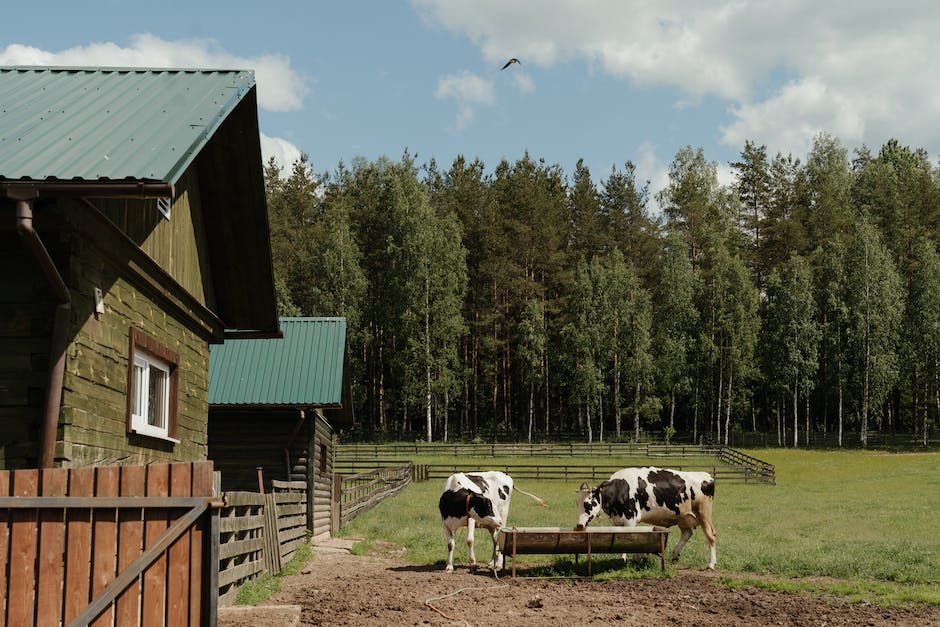
The Science of Dairy Production

Key Challenges in Dairy Farming

Innovations and Technology in Dairy Farming
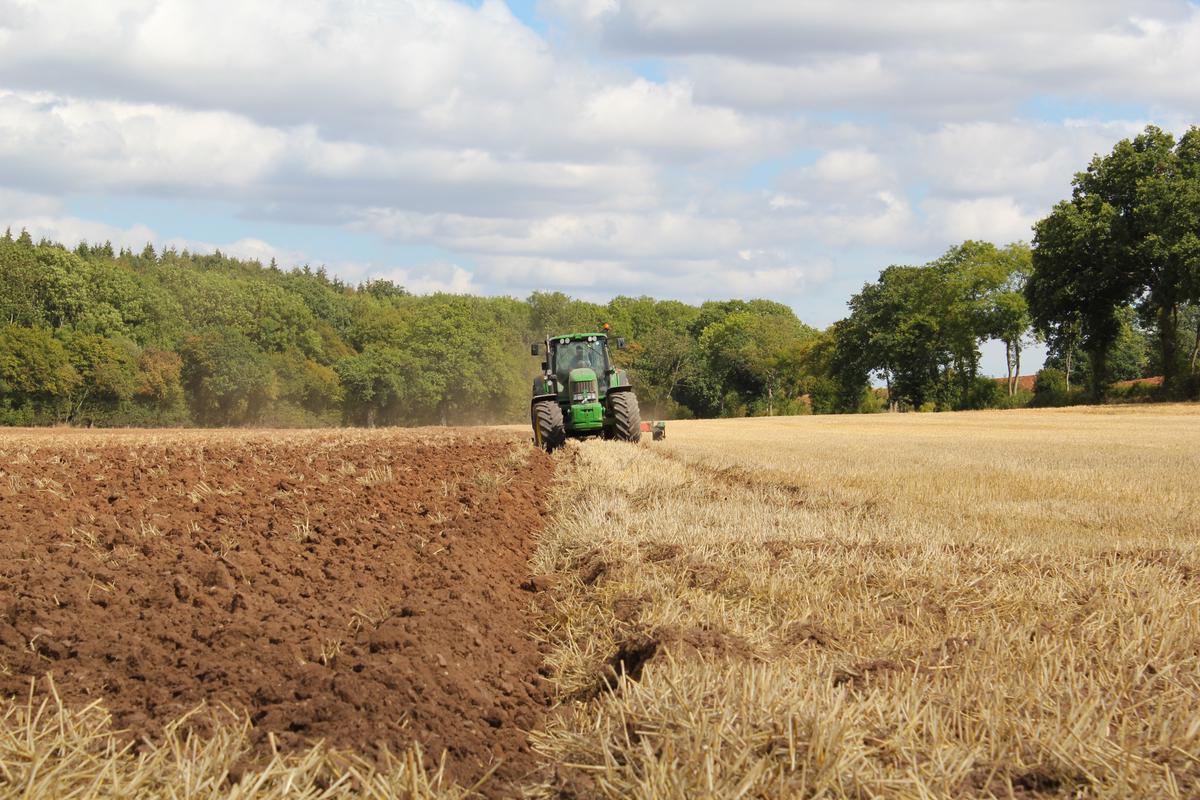
The Future of Dairy Farming
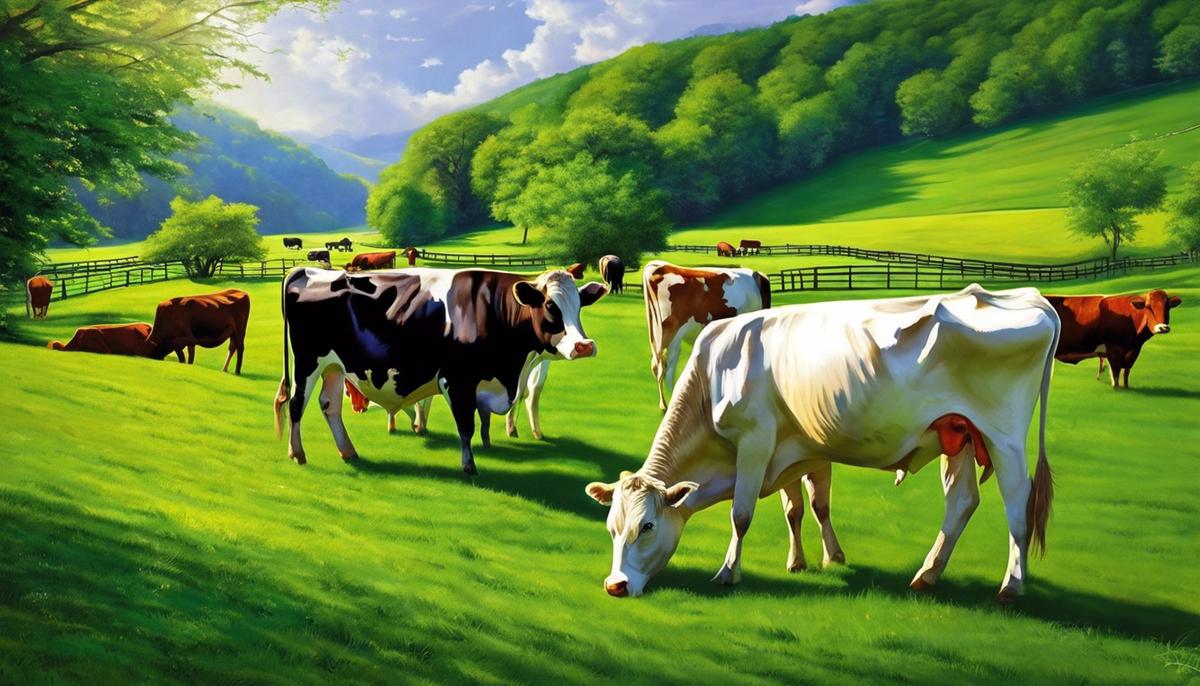

How to start a Dairy farm business?
Understanding Dairy Farming Basics
Essential Principles and Practices in Dairy Farming: A Definitive Guide
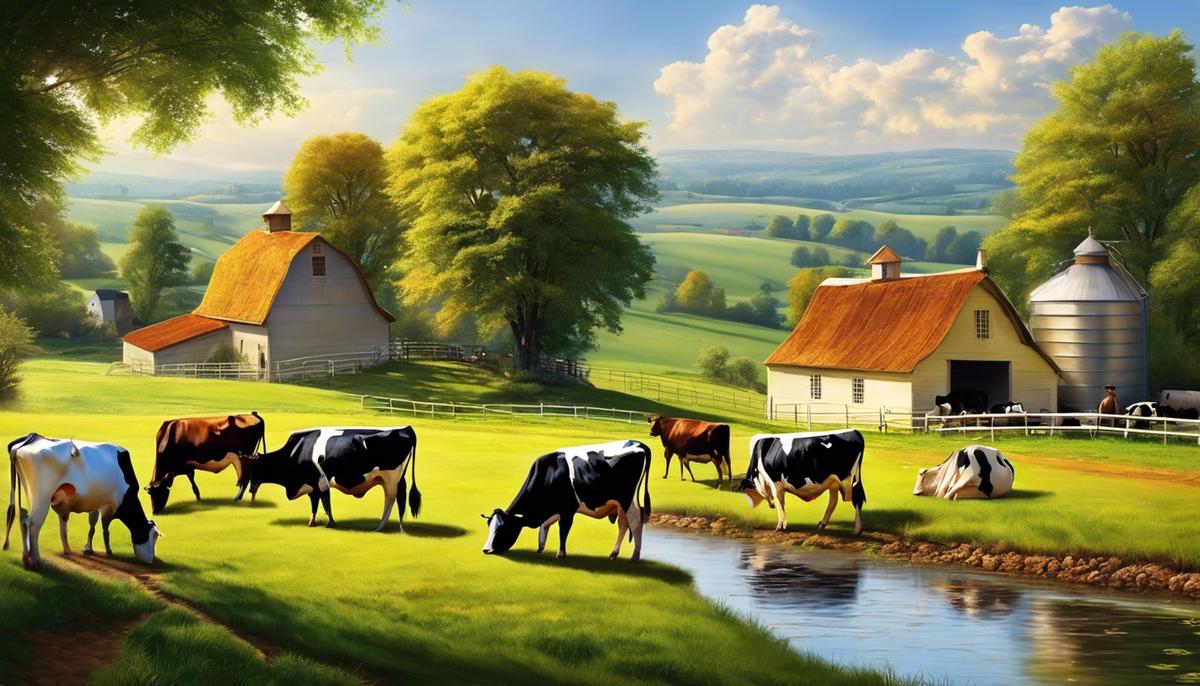
Developing a Business Plan for Your Dairy Farm
Mastering Profitability: Crafting a Top-Tier Dairy Farm Business Plan
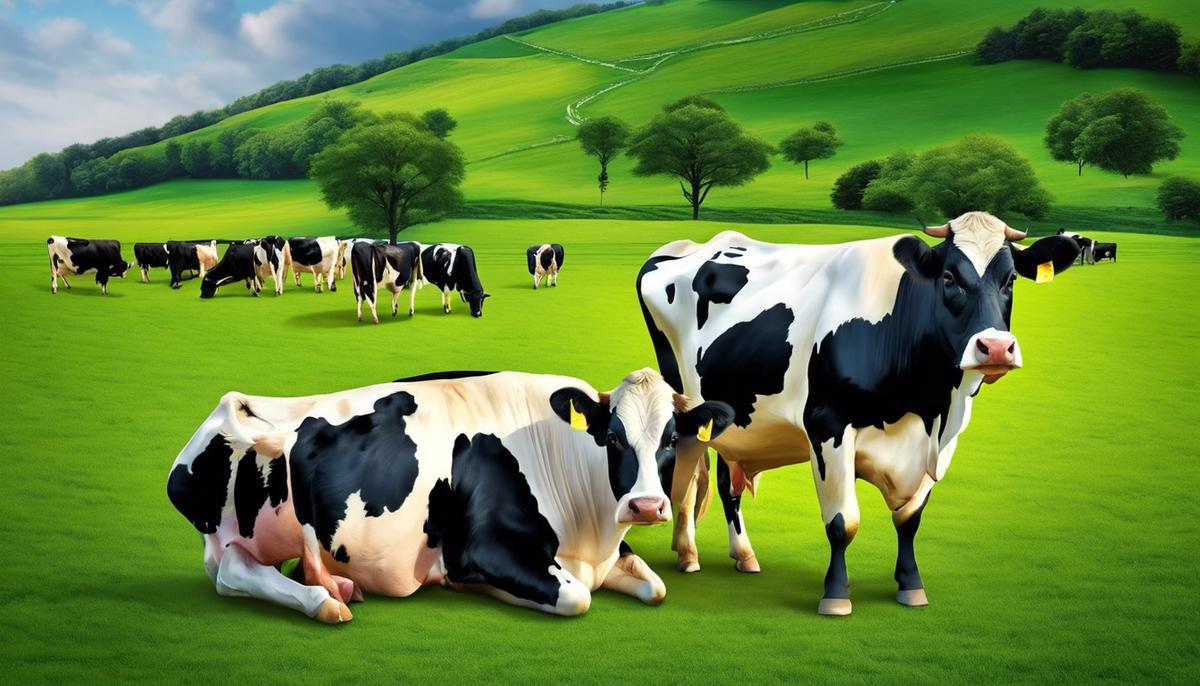
Learning Dairy Farm Regulatory Compliance

Modern dairy farming techniques 2023
Technological Advancements in Dairy Farming
Revolutionizing Dairy Farming: A Dive into the Latest Technological Advancements in the Field
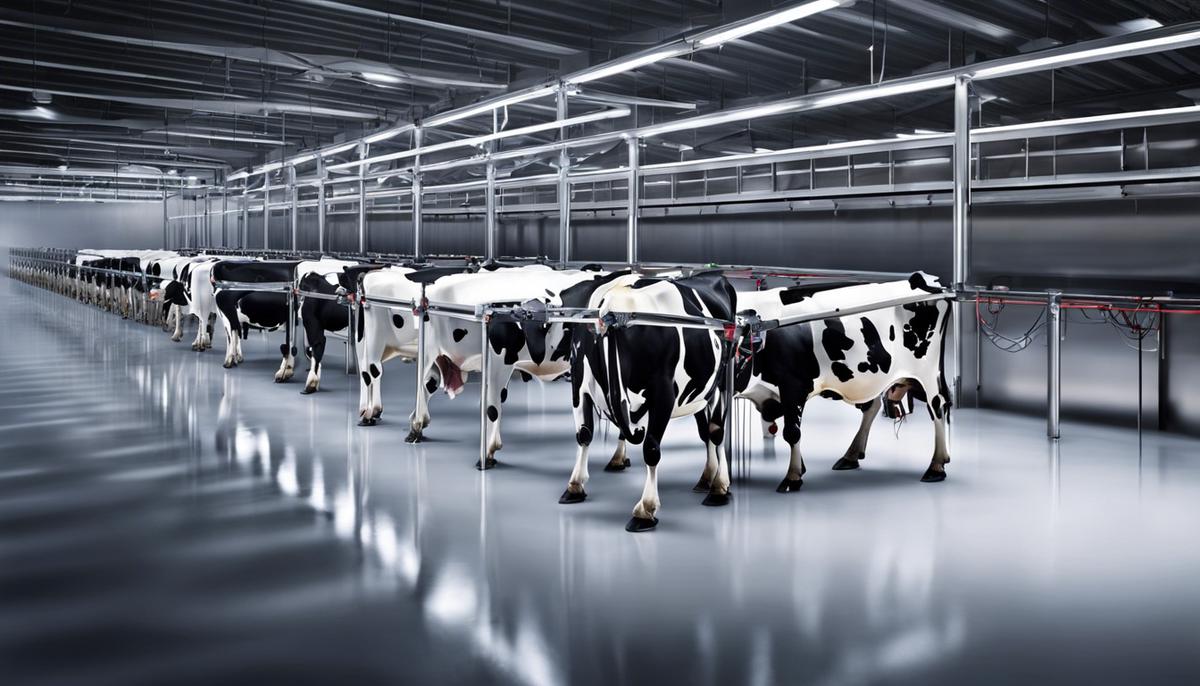
Sustainable Practices in Dairy Farming

Cattle Health and Welfare
Sustainable Breeding: The Genetic Revolution in Dairy Farming
Breeding for Longevity: A Sustainable Approach for Dairy Farming
Precision Livestock Feeding: Striding Towards Environmental Stewardship
Algal Supplements: Nature's Answer to Reduced Methane Production
Recycling Waste: Embracing the Circular Economy within Dairy Farming